Suchergebnisse
Social Low Cost Flex: Gemeinschaftliche flexible Low-Cost- Energieversorgungskonzepte im sozialen Wohnbau
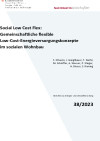
Ziel des Projekts war die Erarbeitung von Konzepten für gemeinschaftliche Erzeugungsanlagen bzw. lokale Energiegemeinschaften in sozialen Wohnbauten sowie die Entwicklung von Low-Cost Ansätzen, um vorhandene thermische und elektrische Flexibilitäten mit minimal invasiven Eingriffen für das Stromsystem zu aktivieren und zur Steigerung des Eigenverbrauchs im Wohnbau bzw. Quartier, aber auch im Sinne des Gesamtsystems zu nutzen. Ergebnis des Projekts sind auf ihre Realisierbarkeit geprüfte Low Cost Konzepte und Geschäftsmodelle zur Umsetzung von gemeinschaftlichen Energieerzeugungs- und –nutzungskonzepten im sozialen Wohnbau.
Schriftenreihe
38/2023
F. Ettwein, J. Ganglbauer, T. Nacht, M. Schloffer, A. Werner, P. Stieger, H. Bieser, S. Raming
Herausgeber: BMK
Deutsch, 37 Seiten
Downloads zur Publikation
GreenTech-Renovation - Energetische Sanierung von gläsernen Gebäuden von architektonischem Wert
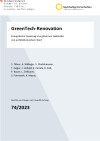
Der Schwerpunkt des Projekts GreenTech-Renovation war, innovative Lösungen zur energetischen Sanierung von architektonisch wertvollen Bauten mit hohen Glasanteil zu finden. Dafür wurde ein zukunftsweisendes bauphysikalisches Konzept entwickelt, das den Einsatz alternativer Energieformen beinhaltet. Ein intelligentes Nutzungskonzept kann mit ökologischem und sozialem Engagement die energetischen Sanierungskonzepte verstärken und deren Nachhaltigkeit garantieren. Die 10-R der Kreislaufwirtschaft (Refuse, Rethink, Reduce, Reuse, Repair, Refurbish, Remanufacture, Repurpose, Recycle, Recover) dienen dabei als Leitlinie.
Schriftenreihe
74/2023
S. Tillner, A. Willinger, S. Stockhammer, T. Zelger, J. Leibold, E. Paráda, D. Bell, P. Bauer, L. Zeilbauer, S. Formanek, K. Mauss, B. Lipp, T. Dobra
Herausgeber: BMK
Deutsch, 152 Seiten
Downloads zur Publikation
Integration von Begrünung in den österreichischen Energieausweis (GREENergieausweis)
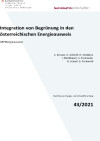
Anpassung der Berechnungsmodelle im Energieausweis derart, dass Gebäudebegrünung darin möglichst realistisch abgebildet werden kann und Abschätzung zur Akzeptanz einer Umsetzung bei relevanten Stakeholdern.
Schriftenreihe
43/2021
C. Kresser, E. Schriefl, H. Schöberl, I. Mühlbauer, S. Formanek, B. Scharf, G. Frühwirth
Herausgeber: BMK
Deutsch, 71 Seiten
Downloads zur Publikation
Circular Economy Summit Austria
22. März 2022
Aula der Wissenschaften, Wollzeile 27a, 1010 Wien
Um Österreich für die gesellschaftlichen, wirtschaftlichen und auch klimapolitischen Herausforderungen zukunftsfit zu machen, ist eine tiefgreifende Transformation unseres Gesellschafts- und Wirtschaftssystems notwendig. Das BMK lädt Sie herzlich zum “Circular Economy Summit Austria” ein, der die Informationsbasis verbreitern, Handlungsanleitungen für die Zukunft erarbeiten und einen breiten Diskurs zwischen Politik, Wirtschaft, Wissenschaft und Zivilgesellschaft eröffnen soll.
Technologiereport: Digitalisierung der Bau- und Immobilienbranche
In der Vielzahl digitaler Möglichkeiten ist es nur sehr schwer möglich, einen Überblick zu behalten, Trends und Potentiale abzuschätzen sowie Zusammenhänge zu erkennen. Der vorliegende Report zielt daher darauf ab, den aktuellen Stand der Technik und die Markteinschätzung vielversprechender digitaler Technologien zu beschreiben. Es werden Informationen über konkrete Anwendungsfälle, Mehrwert und Herausforderungen der jeweiligen Technologien bereitgestellt. Die dargestellten Analysen dienen der Potentialbewertung und der strategischen Weichenstellung zur Integration der aktuell wichtigsten digitalen Technologien der Bau- und Immobilienbranche.
IBA meets Gebäudebegrünung - Voneinander lernen, selber tun. Workshop & Diskussion
19. Oktober 2022, 16:00 – 20:00 Uhr
IBA-Zentrum Wien, Nordwestbahnstraße 16, 1200 Wien
Die Veranstaltung von GRÜNSTATTGRAU holt F&E Begrünungsprojekte, die innerhalb der letzten 5 Jahren umgesetzt wurden, wie zum Beispiel MUGLI; die Richter Schule, das Meidlinger L, etc, vor den Vorhang.
Stakeholderdialog Biobased Industry - Hightech auf Biobasis
5. Dezember 2022
Wirtschaftskammer Österreich, Wiedner Hauptstraße 63, 1045 WienJulius Raab Saal
Im Mittelpunkt standen aktuelle Forschungs- und Entwicklungsaktivitäten im Themenfeld "Biobasierte Industrie" aus den unterschiedlichen FTI-Initiativen des BMK sowie dem Circular Bio-based Europe Joint Undertaking. Die Veranstaltung fand in Kooperation mit dem Fachverband der chemischen Industrie Österreichs statt.
Innovationen für kühle Stadtoasen
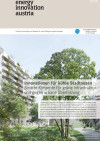
Smarte Konzepte für grüne Infrastruktur und gegen urbane Überhitzung
energy innovation austria
3/2018
Herausgeber: BMVIT und Klima- und Energiefonds
Deutsch, 8 Seiten
Downloads zur Publikation
34. BIOEM in Großschönau
20. - 23. Juni 2019
BIOEM Gelände Großschönau, Großschönau, AT
Die BIOEM in Großschönau ist mit mehr als 250 AusstellerInnen und 20.000 BesucherInnen pro Jahr Niederösterreichs größte Energiespar- und Hausbaumesse.
Energieschwamm Bruck
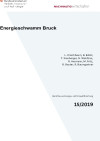
Im Sondierungsprojekt für die Stadtregion Bruck/Oberaich "Energieschwamm Bruck" wurden klare Grundlagen zur Entwicklung und Flexibilisierung des zukünftigen kommunalen Energiesystems in Form eines Energieentwicklungskonzeptes und eines Katasters möglicher Umsetzungsprojekte erarbeitet. Aus dem für Bruck angewendeten, strukturellen Lösungsprozess wurde eine allgemein gültige Lösungsmethode für Städte mit 10.000-25.000 Einwohnern abgeleitet.
Schriftenreihe
15/2019
L. Kriechbaum, B. Böckl, T. Kienberger, N. Wohltran, R. Hermann, M. Fritz, R. Rauter, R. Baumgartner
Herausgeber: BMVIT
Deutsch, 62 Seiten
Downloads zur Publikation
Symposium: Konsum Neu Denken
17. - 18. Oktober 2019
Institut für Höhere Studien, Josefstädterstraße 39, 1080 Wien
Das Symposium bietet Raum, um aus wissenschaftlicher und aus praxisbezogener Perspektive die Relevanz, die Wechselwirkungen sowie die Möglichkeiten und Grenzen der genannten Phänomene des Reparierens, des Selbermachens, länger Nutzens und des Kreislaufwirtschaftens zu diskutieren.
Cooling Citites
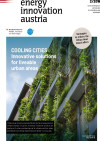
Innovative solutions for liveable urban areas
energy innovation austria
2/2019
Herausgeber: BMVIT und Klima- und Energiefonds
Englisch, 12 Seiten
Downloads zur Publikation
City of Tomorrow
City of Tomorrow puts emphasis on the built infrastructure in connection with urban energy systems, both on a district-level and within the wider agglomeration (suburban areas).
DW² - Entwicklung einer thermisch verbesserten Schlitzwandkonstruktion
Die thermischen Eigenschaften von Schlitzwandkonstruktionen werden durch die Anwendung neuer Materialien und Herstellungsmethoden verbessert und durch Labor- und Feldversuche validiert sowie durch numerische und ökologische Betrachtungen ergänzt. Das Ergebnis kann bei der Errichtung von energetisch verbesserten unterirdischen Bauwerken wie beispielsweise Tiefgaragen oder zur Herstellung von Erdwärmespeichern verwendet werden.
DW² - Thermal improvements on diaphragm walls
New materials and installation methods for diaphragm walls will be investigated in laboratory and field tests in order to improve the thermal properties of the construction elements. Additional numerical and ecological aspects are considered to ensure an energetic enhancement of underground constructions such as underground garages or thermal energy storages.
Themen
Das Programm "Stadt der Zukunft" hat sich zum Ziel gesetzt das Erreichen der Klimaneutralität in Städten zu ermöglichen und essentiell zu beschleunigen. Dafür ist es notwendig, dass – neben den Forschungsprojekten – ein wirksames und begleitendes Programm- und Themenmanagement betrieben wird, welches auf den Erfahrungen des Vorgänger-Programms „Haus der Zukunft" aufbaut und Konzepte, Technologien und Lösungen für zukünftige Städte und Stadtquartiere entwickelt. Die Ergebnisse aus den Forschungsprojekten und Erkenntnisse aus dem begleitenden Themenmanagement schaffen dadurch einen essentiellen Mehrwert für Forscher:innen und zukünftige Anwender:innen.
HotCity - Gamification als Möglichkeit für die Generierung von Daten zur energieorientierten Quartiersplanung
Ziel des Projekts war ein Funktionstest, ob durch Gamification kosteneffizient, rasch und zuverlässig ein aktueller Datensatz von energierelevanten Daten zur Quartiersplanung erhoben werden kann. Dies wurde am Beispiel der Potenzialermittlung von industriellen und gewerblichen Abwärmequellen in Wien und Graz ermittelt.
HotCity - Gamification as a possibility to generate data for energy-oriented neighbourhood planning
The aim of the project was a functional test to determine whether an up-to-date data set of energy-oriented data can be collected for neighbourhood planning through gamification, cost-efficiently, quickly and reliably. This had been determined using the example of the potential determination of industrial and commercial waste heat sources in Vienna and Graz.
ParaSol - Multifunktionale solaraktive Platz- und Straßenüberdachung Leoben
Am Use Case Leoben wird erstmals an konkreten Orten ausgelotet, welche stadträumlichen Auswirkungen, Synergie- und Energiepotentiale neu zu entwickelnde, solaraktive Platz- und Straßenüberdachungen in Form von weitgespannten Konstruktionen in Leichtbauweise im öffentlichen urbanen Raum mit sich bringen und wie sie sich auf das Stadtbild und die Stadtfunktion auswirken.
ParaSol - Multifunctional solar canopies for urban streets and places
With the city of Leoben as a use case this exploratory project will, for the first time ever, examine the spatial effects, synergy- and energy potentials of newly developed wide-span light-weight solar canopies for streets and squares in urban public space as well as their implications on the townscape, the image of the city and the city function.
